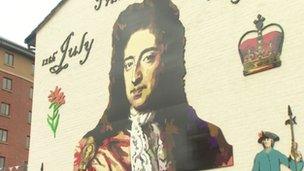King Billy Ireland
- Famous March birthdays including Justin Bieber, Cash Baker, Txunamy, Gavin Magnus, Madison Beer and many more.
- As King of Scotland, he is known as William II. He is sometimes informally known as 'King Billy' in Ireland and Scotland. His victory at the Battle of the Boyne in 1690 is commemorated by unionists, who display orange colours in his honour. Popular histories usually refer to his joint reign with his wife, Queen Mary II, as that of William and Mary.
- Online Casino Payments Available Currencies. King Billy Casino is a safe multi-currency online casino where you can open wallets in currencies of your choice. We accept the following currencies: Euro (€), US Dollar ($), Canadian Dollar (C$), Australian Dollar (A$), New Zealand Dollar (NZ$), Norwegian Krone (kr), Japanese Yen (¥), Indian Rupee (₹), South African Rand (R), Russian Ruble.
King Billy Casino review - A 100% bonus up to € 200 extra, plus 200 Free Spins with your first deposit. Irish players are accepted. Games developed by NetEnt, Microgaming, Pragmatic Play and more providers at KingBillyCasino.com. Play casino games on your PC, Smartphone or Tablet.
Our editors will review what you’ve submitted and determine whether to revise the article.
Join Britannica's Publishing Partner Program and our community of experts to gain a global audience for your work!
William III, byname William of Orange, also called William Henry, prince of Orange, Dutch Willem Hendrik, prins van Oranje, (born November 14 [November 4, Old Style], 1650, The Hague, Netherlands—died March 19 [March 8], 1702, London, England), stadholder of the United Provinces of the Netherlands as William III (1672–1702) and king of England, Scotland, and Ireland (1689–1702), reigning jointly with Queen Mary II (until her death in 1694). He directed the European opposition to Louis XIV of France and, in Great Britain, secured the triumph of Protestantism and of Parliament.
Early life

The son of William II, prince of Orange, and of Mary, the daughter of Charles I of England, William was born at The Hague in November 1650, eight days after his father’s death. As stadholder of five of the United Provinces of the Netherlands, William II had recently incurred the enmity of a powerful minority of a republican oligarchy that dominated the province of Holland and the city of Amsterdam. After his death this party determined to exclude the house of Orange from power, and the Act of Seclusion (1654) debarred the prince of Orange and his descendants from holding office in the state.
William III’s education, nevertheless, was, from the first, the training of a ruler. Contemporaries agree that he was a boy of great vivacity and charm, but frequent quarrels between his mother and his paternal grandmother disturbed his childhood and may have helped to breed the habit of reserve that was intensified by the difficulties of his later life. In 1660, after his uncle Charles II’srestoration to the English throne, the Act of Seclusion was rescinded. Shortly afterward his mother died, leaving him to the guardianship of his grandmother and of his uncle Frederick William, elector of Brandenburg.
Early in 1666 he was made a ward of the States General, the representative assembly of the United Provinces. Under Johan de Witt, the grand pensionary of Holland, he acquired a specialized knowledge of public business. His exceptional promise and the popular devotion he had inherited made it impossible to deny him all advancement, but the Perpetual Edict (1667) decreed that the offices of stadholder and captain general, formerly held simultaneously by the princes of Orange, should never again be held by the same person.
Stadholder
In 1671 it became clear that Louis XIV of France and Charles II of England were planning a joint attack on the United Provinces, and demands for William’s appointment as captain general became insistent. He was appointed in February 1672, though at first with very limited authority. In March and April Charles and Louis declared war, and in June French troops crossed the Rhine River and overran three provinces in as many weeks. The Dutch navy was able to hold the English in check, but the army had been neglected and was ill-trained and ill-equipped. As a last expedient the polders, or low-lying areas, were flooded, and William, with his few unseasoned troops, was left to defend the “water line.”
Panic broke out in the country, and there were angry demands for the prince’s elevation to the stadholderate. The few dissenters were overruled, and on July 8 (New Style) he was proclaimed stadholder by the States General, later ratified by the provincial estates of the occupied provinces. One of his first acts, done with the States’ approval, was to refuse the ruinous peace terms offered by the two kings. Civil disorders, however, were not over. On August 20 Johan de Witt and his brother, who were unjustly suspected of treachery, were murdered by an infuriated mob at The Hague. William was in no way implicated in the crime and was enraged when he heard of it, but, because of the number of the murderers and perhaps because of the general revolutionary situation, he failed to bring them to justice.
In a few weeks the country settled down and for a year held out almost alone. In the autumn of 1672 William had enlisted the aid of the Holy Roman emperor Leopold I and the elector of Brandenburg, and in 1673 Spain joined the alliance, but their help was not immediately effective. William, meanwhile, was steadily rebuilding his army and in September 1673 recaptured the key fortress of Naarden. He then moved swiftly into the territory of Cologne, joined his forces to those of the emperor, and on November 12 captured Bonn. The French, threatened with encirclement, hurriedly evacuated the United Provinces. Charles II and Louis’s minor allies were forced to make peace early in 1674. Louis’s Dutch adventure had failed and had turned half of Europe against him, but he still held many places in Germany and the Spanish Netherlands, so the war continued and spread into remoter parts of the continent. William’s chief concern for the next four years was the command of the Dutch armies in Flanders, though Dutch domestic affairs and repeated attempts to find an acceptable peace formula took much of his time. Peace was finally made by a series of treaties in 1678 and 1679.
- born
- November 14, 1650
The Hague, Netherlands
- died
- March 19, 1702 (aged 51)
London, England
- king, Ireland (1689-1702)
- king, Scotland (1689-1702)
- king, England (1689-1702)
- stadtholder, Dutch Republic (1672-1702)
- role in
- house / dynasty
- spouse Mary II
- father William II
- mother Mary of Orange
FOR IMMEDIATE RELEASE: January 9, 2020

Carta Monir Donates Original Art to Billy Ireland Cartoon Library & Museum
Carta Monir, original art for forthcoming graphic novel “I Want To Be Evil”
COLUMBUS – Cartoonist Carta Monir has donated hundreds of pages of original art, including complete and near complete works, to The Billy Ireland Cartoon Library & Museum.
Carta Monir is also the founder and publisher behind Diskette Press, a small-press publishing house which focuses on publishing and distributing mini comics and zines by trans and queer comics makers. Monir’s own minicomics and zines marry her fascination for analog technologies with autobiographical narratives about her experiences as a trans woman, family loss, abuse, grief and resiliency. Video and computer games appear frequently as a motif throughout Monir’s work, which she uses as a vehicle for blending perceptions of reality, the body, and the future with dysphoria, memory, violence and discovery.
Monir says the donation includes, “nearly all of the original art I created since the end of college, including a substantial amount of art I created before coming out as a woman. Many of the pieces are no longer in print, and some of them have never been printed anywhere. Most of the stories are complete, although some (such as Secure Connect and RIPMOM) are missing pages which I gave away as gifts to friends and lovers.”
King Billy Ireland Wikipedia
King Billy Ireland
In addition to Secure Connect and RIPMOM, BICLM was honored to receive original art from Monir’s Cave Dreams, Lara Croft Was My Family,Stealth Mechanic and I Still Want To Kill That Boy as well as partial and complete art for various other zines and web comics. The collection also includes the art for Ready to Pop, which appeared in the 2019 anthology Drawing Power: Women’s Stories of Sexual Violence, Harassment, and Survival edited by Diane Noomin.
Caitlin McGurk, Associate Curator and Assistant Professor, said of the collection “The voice that rings through Carta Monir’s work is singular, thought-provoking, and unafraid. We are so honored that she has trusted us at The Billy Ireland Cartoon Library & Museum with preserving these deeply personal stories for future generations of students, scholars, and fans to study and find inspiration. Monir’s work has already appeared in two of our museum exhibitions, Koyama And Friends: Publishing, Patronage, And The New Alternative Press, and currently, Ladies First: A Century of Women’s Innovations in Comics and Cartoon Art. With this generous addition of her artwork to our collection, I am certain it will appear in many more.”
“I chose to donate my original art to the Billy Ireland Cartoon Library & Museum for several reasons” stated Monir via email. “I love visiting [The Billy Ireland Cartoon Library & Museum] and have had some very emotional experiences there. Knowing that my art would be taken care of alongside the art of some of my greatest heroes just means the world to me. I believe deeply in the work that Caitlin McGurk and the rest of the team is doing, and I know my art will be treated with care and respect. I encourage other creators to donate their original work to the Billy Ireland as well.”
Carta Monir’s first graphic novel, I Want To Be Evil, will be published by Youth in Decline. The book focuses on her late mother’s terminal cancer, and Monir’s experience with coming out to her family.

In 2019, Monir was the recipient of the Cartoon Crossroads Columbus (CXC) Emerging Talent Award.
Click to learn more about Carta Monir and Diskette Press.